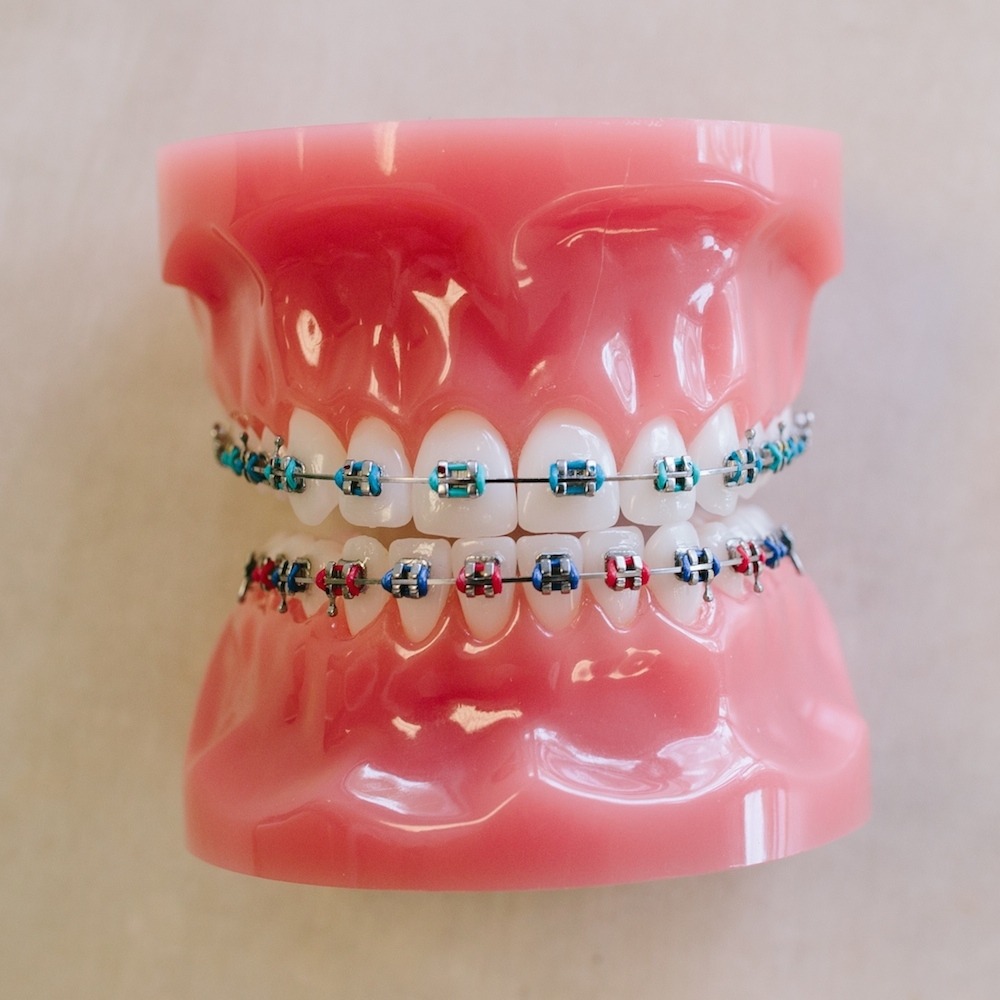
Traditional braces have been around for a very long time, and are probably the most recognizable symbol of orthodontics. These orthodontic workhouses have a well-established history of successful treatment, and are incredibly efficient at correcting oral issues ranging from mild to complex.
What are braces composed of?
Brackets
The brackets are typically made from a mix of stainless steel, nickel, and other metals, and are very durable and long-lasting. Brackets have little hooks or doors, over which the wire is threaded. A bracket can be secured by closing the door, or by applying an elastic over the top of the wire.
Glue
This is what Dr. Kyle Fagala will use to attach the brackets to your teeth. Although some orthodontists may attach the brackets to a metal band which is then crimped around the tooth to hold it in place, it’s much more common these days to attach the bracket directly to the tooth with glue (technically, a form of composite bonding material). In cases that require more serious treatment, metal bands may be used together with glue to give the braces more leverage and stability.
Wire
This thin piece of metal runs from one bracket to another. Dr. Kyle will change the shape and curvature of the wire in order to move your teeth in the desired direction. Crimps may be made in the wire to help push or pull any teeth that are especially stubborn. In some cases, the wire will attach all the bottom or upper teeth together, but we might occasionally cut the wire strategically if connecting just a few teeth is better for the treatment plan.
Elastics
For patients who need bite correction, elastics are essential. They are generally strung between an upper bracket hook and a lower bracket hook, pulling the upper jaw backwards to correct an overbite, or the lower jaw backwards to correct an underbite. We may also employ rubber bands for many different situations, especially when we want to exert extra pressure on the teeth or jaws.
Other terms you may hear Dr. Kyle mention in connection with your metal braces are:
Orthodontic bands
These are stainless steel rings that are cemented to the teeth using dental bonding agents. These bands can provide an anchor for the braces and oftentimes Orthodontic appliances, but they are not used with all patients.
Spacers
These small elastic “donuts” or rings can be used to create space in between the teeth when needed, typically before bands are placed. They are also referred to as separators.
Elastic ties/o-rings/ligatures/colors
These tiny rubber rings or bands can be used to attach the arch wire to the brackets. They are less rigid than spacers and come in dozens of colors.
How do braces work?
Before applying the brackets, Dr. Kyle and our team will collect photos and X-rays of your mouth. Sometimes we will us our iTero Element scanner to scan each of your teeth and the layout of your gums and mouth. If necessary, this process takes 10-15 minutes and provides an extremely accurate 3D view of your mouth. Once the records and optional scan are complete, the data will be used to help formulate a customized treatment plan, including how each tooth needs to be moved in order to get it in the best possible position. Dr. Fagala will then decide how to place the brackets based on this information. For example, if you have some teeth that need to be tilted, the positioning of those brackets will be different than the positioning of brackets for teeth that need to be turned.
Once the brackets have been attached, the wire will be inserted. Bends in the wire are used to provide different types of pressure on different teeth. A bend in the wire is how most orthodontists encourage specific and precise movements. For example, helping a tooth that is twisted to turn and face the right way, or aligning one tooth that is too far forward with one that is too far back. This process of tooth movement is called remodeling, and it involves minor changes in the bone that surrounds the roots of teeth.
Want to know more about the science behind remodeling? When pressure is put on the tooth, cells called osteoblasts and osteoclasts form around the tooth’s root. The pressure of the wire and the osteoblasts and osteoclasts together create a negative pressure on one side of the tooth. At this site, bone is removed. On the other side of the tooth, bone is reformed. The tooth will then slowly move into the correct position as pressure is put on the tooth and the bone of the tooth and the jaw is remodeled.
This process is only able to occur if constant pressure is put on the tooth. As bone is absorbed on one side and then deposited on the other side, the tooth can move. Once the pressure stops - like when we remove your braces - the tooth will begin to settle into its new position. However, most teeth will start to drift back to their old positions over time. This is why patients are given retainers. When worn as directed, a retainer will help keep teeth in their new, improved positions and prevent this natural drifting.
What can I expect from today’s metal braces?
 In the past, metal braces had a reputation for being a bit awkward and obvious, but modern orthodontics has produced versions that are smaller, less conspicuous, and far more comfortable than ever before! Sleeker brackets and lighter wires improve the appearance and feel of these braces, and help keep irritation in the mouth to a minimum.
In the past, metal braces had a reputation for being a bit awkward and obvious, but modern orthodontics has produced versions that are smaller, less conspicuous, and far more comfortable than ever before! Sleeker brackets and lighter wires improve the appearance and feel of these braces, and help keep irritation in the mouth to a minimum.
Traditional metal braces also come with a fun new twist without any extra cost - you can customize them with pops of color! The elastics that fit around brackets come in a wide variety of colors, and let you showcase your personality whenever you want. Pick your favorite color combination, the colors of your favorite sports team, even your school colors! We also offer silver, gray, white, black, and tooth-colored elastics for patients seeking a more subtle look.
Braces are incredibly efficient at fixing complex tooth issues, and can work faster at closing gaps and aligning teeth than other treatments might, potentially shortening your treatment time. They don’t require some of the more complex technology or expensive equipment that newer treatments might, often making metal braces a cost-effective option. The strength, durability, and affordability of traditional metal braces keep them the top treatment for orthodontic patients, year after year!
Bonus: because metal braces get right down to work, you’ll often be able to see some signs of progress in a relatively short period of time. It may not seem like much, but sometimes seeing even a slight improvement in your smile can give you a boost of encouragement on your orthodontic journey!
How do I care for my metal braces?
 Maintaining your metal braces can sometimes be a bit of a challenge, particularly during the first few weeks, but with patience and practice, you’ll get the hang of a good dental hygiene routine in no time!
Maintaining your metal braces can sometimes be a bit of a challenge, particularly during the first few weeks, but with patience and practice, you’ll get the hang of a good dental hygiene routine in no time!
Food particles can get stuck in the various nooks and crannies of braces, giving bad bacteria a place to grow, so it’s more important than ever to keep your braces and teeth clean and free of debris during the orthodontic process. Brushing and flossing thoroughly with brackets, wires, and bands can be tricky, though. Fortunately, there are a number of accessories available that can make oral hygiene much easier for braces patients. Oral irrigators like a Waterpik use a pressurized stream of water to help rinse out those hard to reach places, and ortho-picks are an excellent choice for braces-specific flossing.
You’ll also need to adjust to the food restrictions that come with traditional braces. Avoid anything too crunchy or too chewy, like some raw fruits and veggies, popcorn, gum, nuts, and several types of candy and sweets. This will protect your brackets and wires while you’re undergoing orthodontic treatment with metal braces. Remember, this part is only temporary and will be worth it for the smile you see in the mirror when your braces come off!
Our front office will schedule you for follow-up visits with us at regular intervals throughout your treatment, usually about every 6-10 weeks. During these adjustment appointments, Dr. Fagala will change the bands that are attached to the brackets, and the wire may be replaced at this time as well. We do our best to keep these appointments short (around 20 minutes), so you can get back to work, home, or school as quickly as possible! You may experience some slight residual soreness following an adjustment appointment, but it should only be temporary.
Don’t skip these follow-up visits! They’re a very important part of your overall treatment plan, and will help us ensure you get very best results in the least amount of time possible.
How long will I be in braces?
The million dollar question! …..and the one we don’t have a concrete answer for. Sorry! Every mouth is different, and every patient responds to treatment in their own way, so treatment time with metal braces will vary on a case-by-case. The average time spent in metal braces tends to be around 18 to 22 months, but could be shorter or longer, depending on the individual. We have patients in braces for as little as 6 months, and for complex issues, it can take over 3 years to complete the braces process. Remember, though, that with metal braces, signs of improvement can often be seen in just a short period of time, which can help give you confidence during the treatment process.